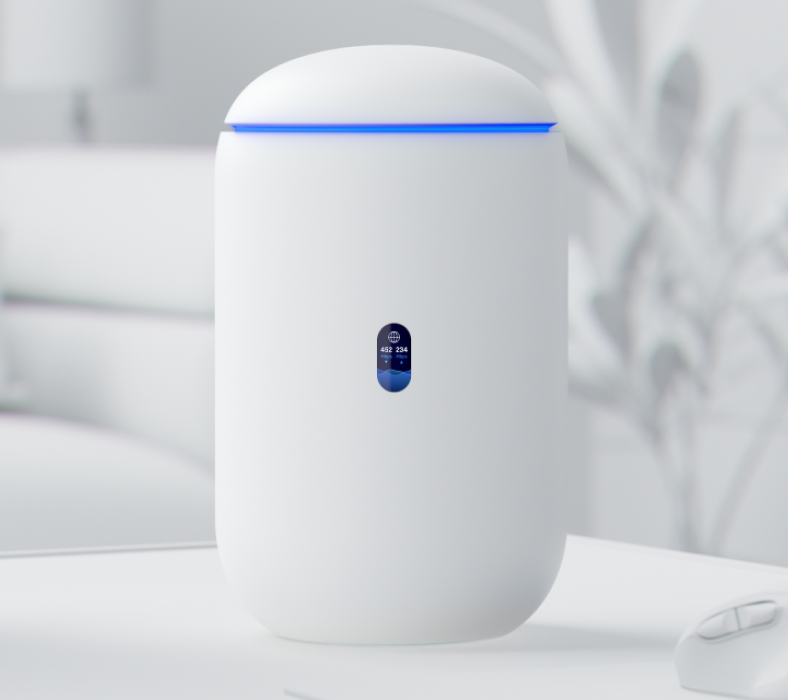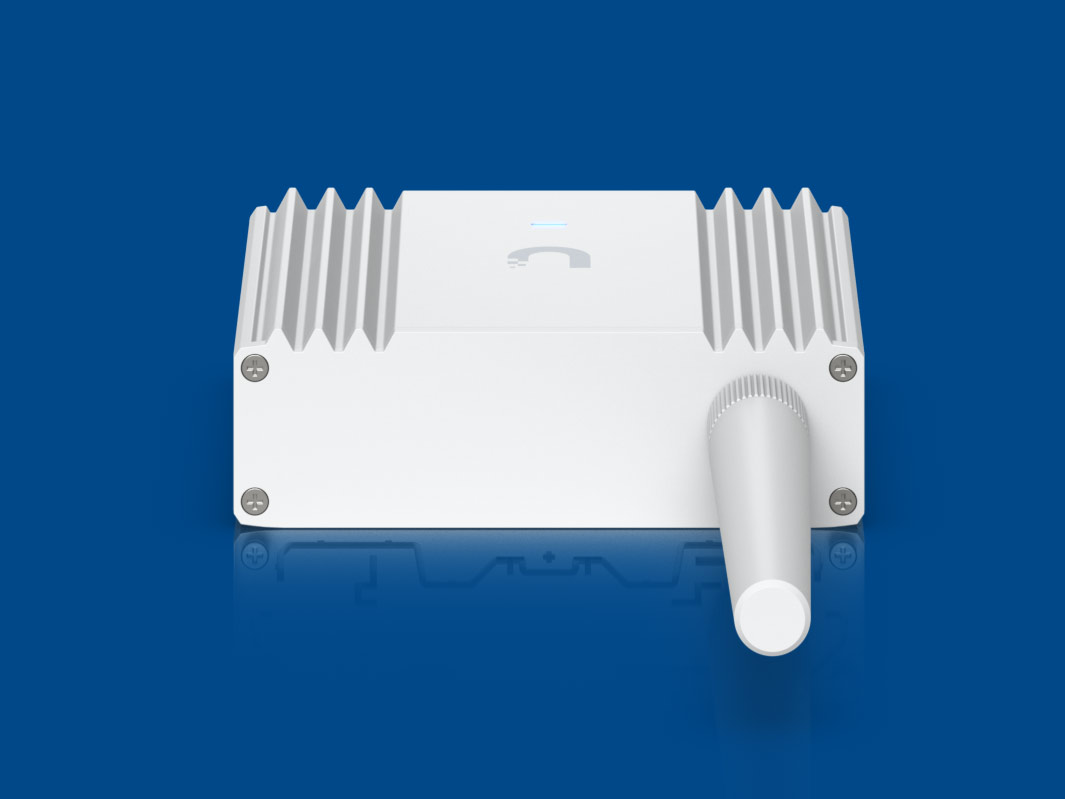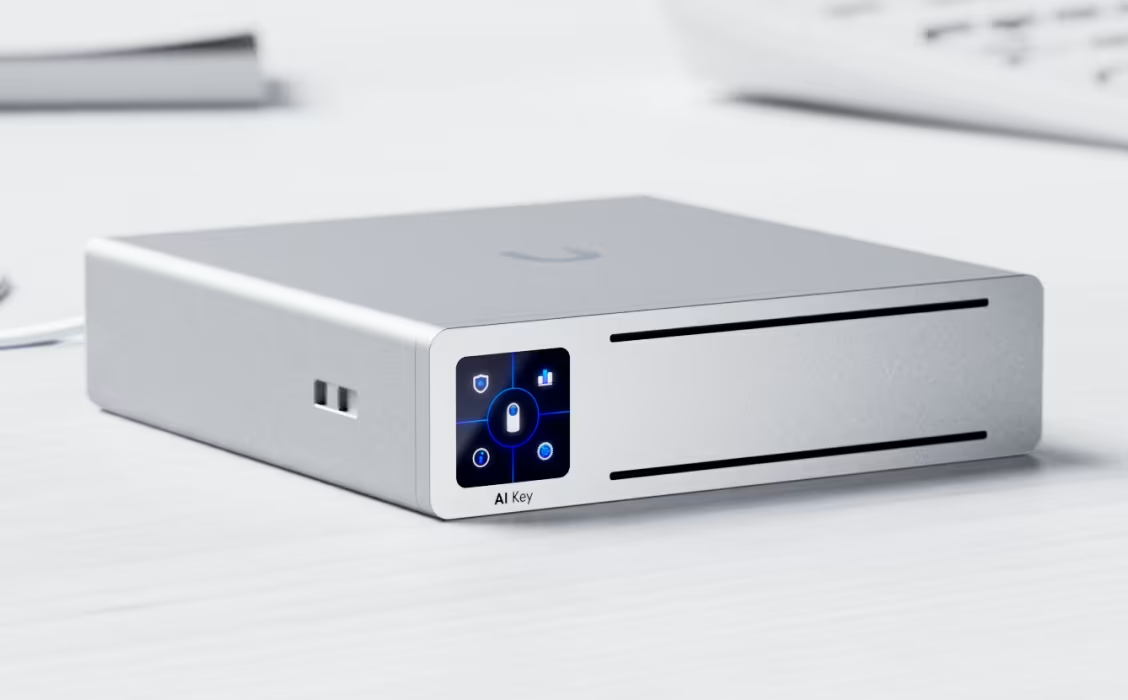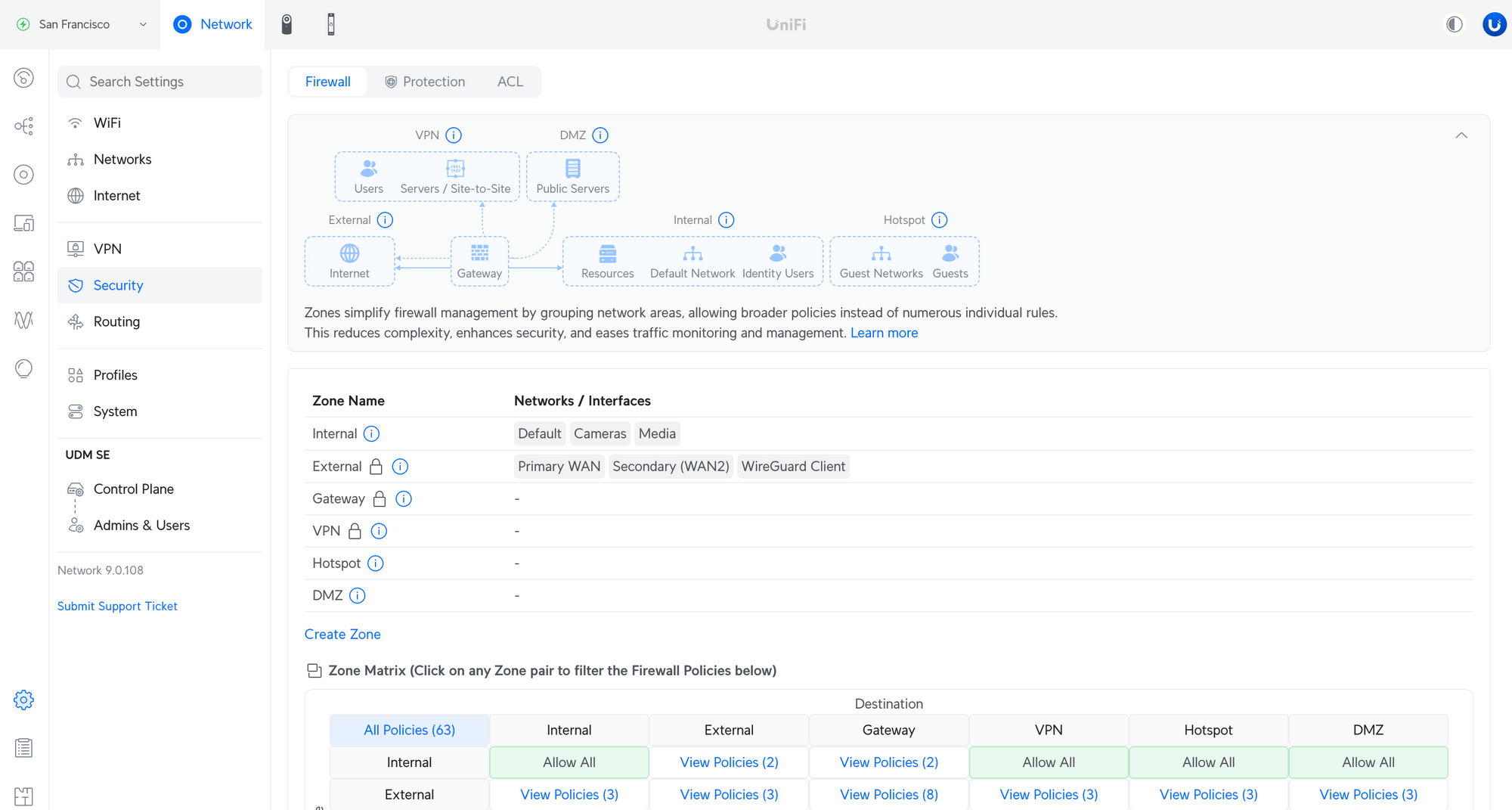
In the ever-evolving world of network security, staying ahead of the curve is crucial. UniFi, a leading brand in networking technology, has recently launched a revolutionary update to its firewall system in UniFi Network 9. With the introduction of the zone-based firewall, users are presented with a more streamlined, intuitive, and powerful way to manage network security.
If you’ve been hesitant about change or are unsure whether this new system is for you, fear not. This blog post will dive deep into the new UniFi firewall features, explain how the upgrade process works, and why the zone-based system is a significant leap forward for both ease of use and security. Let’s explore why this update might just be a game-changer for your network security needs.
1. What’s New with UniFi Network 9?
For years, UniFi users have relied on a traditional firewall setup that, while effective, was often cumbersome and not as user-friendly as it could be. Firewall rules were typically created with a source and destination network, and users had to manually configure each rule to ensure proper access controls. This system worked, but it wasn’t ideal, especially for new users who struggled with understanding all the nuances of firewall rule configurations.
UniFi Network 9 changes that with its zone-based firewall system, which simplifies the process of managing security settings. Instead of working with individual firewall rules for each network, users now group networks into distinct zones, which can be managed as a whole. This change results in more organized, intuitive, and flexible management of firewall settings, making it easier to control what each zone can access and how traffic flows between them.
To learn more about UniFi Network 9 and its features, check out this article from Ubiquiti: UniFi Network 9 Release Notes.
2. Upgrading to the Zone-Based Firewall
One of the most significant updates with UniFi Network 9 is the ability to upgrade your existing firewall to the new zone-based system. While the firewall rules will remain in place after the upgrade, they will be converted to the new format, allowing you to take advantage of the new features.

How the Upgrade Works
Upgrading to the zone-based firewall is a simple process, but there are a few things to keep in mind. If you already have a production device, you’ll first need to create a test device to ensure everything works smoothly. The upgrade process itself involves a few clicks, and the firewall rules are automatically updated to fit the new structure. Although the system will migrate your existing rules, it’s essential to review them after the upgrade to ensure everything is working as expected.
If you want to see the upgrade process in action, watch the video below.
3. Understanding Zones and Their Role in Firewall Management
The concept of zones is central to the new UniFi firewall system. Instead of managing individual networks, you now group them into zones, making it easier to apply specific firewall rules and control traffic between different zones.
Here are the default zones available in UniFi Network 9:
- Internal Zone: This includes your trusted networks such as your primary LAN.
- Hotspot Zone: Designed for untrusted guest networks, this zone helps isolate guest traffic from your internal networks.
- DMZ Zone: A specialized zone for publicly exposed services, ideal for hosting servers or applications.
- Development and IoT Zones: These are intended for more specialized network segments like development environments or IoT devices.
You can create custom zones to match the specific needs of your network, giving you much greater control over security.
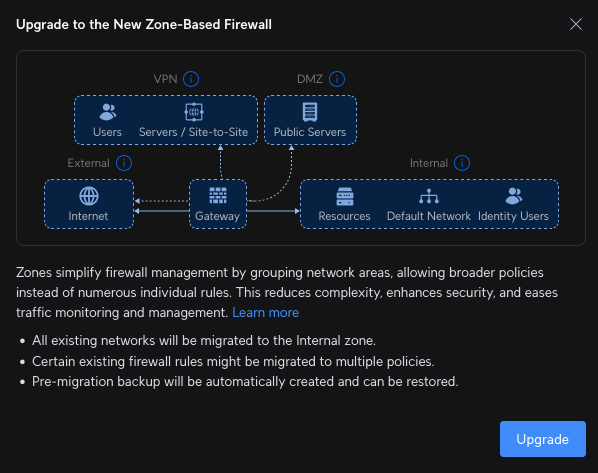
4. The Power of the Matrix: Visualizing Your Firewall Rules
One of the most powerful new features in UniFi Network 9 is the Matrix. This visual representation of firewall rules allows you to quickly see which zones can access each other and what types of traffic are allowed.
The Matrix simplifies firewall management by providing a clear, easy-to-understand visual interface that shows the relationships between zones. As you create new firewall rules, the Matrix automatically updates to reflect the changes, giving you real-time feedback on the security posture of your network.
The Matrix helps identify potential misconfigurations, making it easier to troubleshoot and ensure that your firewall rules are working as intended.
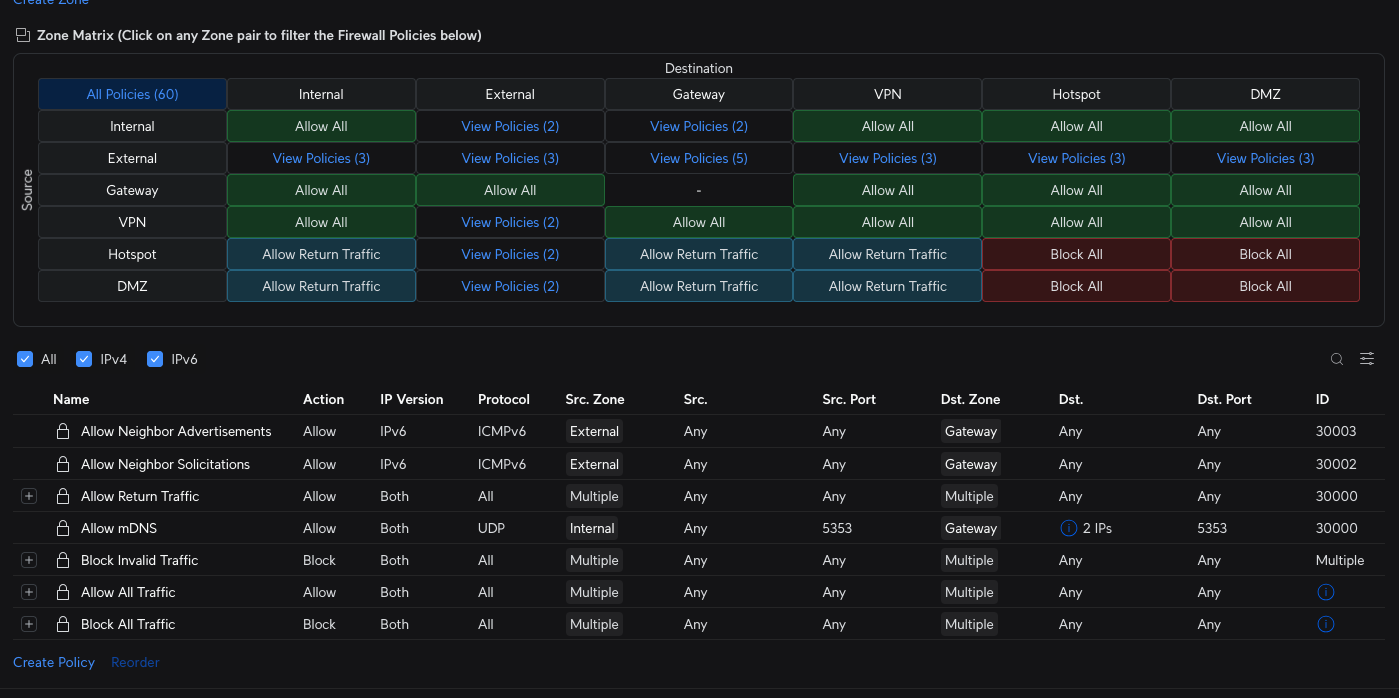
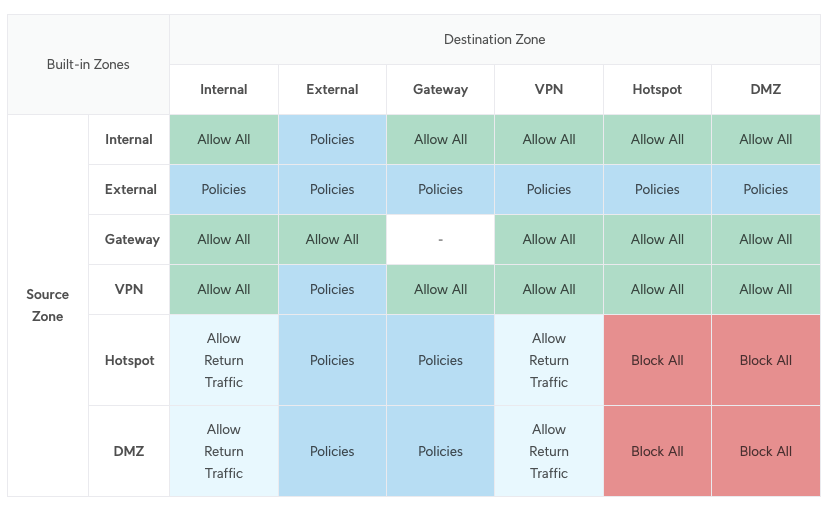
5. Streamlining Firewall Rule Creation with Policies
In the previous UniFi firewall setup, creating firewall rules was often tedious and required a lot of manual input. The new system introduces policies, which are essentially predefined sets of rules that you can apply to zones or networks.
These policies make it significantly easier to create complex firewall rules. For example, you can create a policy that applies to multiple networks in a zone, or you can set up specific rules for individual VLANs. The system is far more flexible and easier to understand than the old rule-based approach.
One of the biggest advantages of policies is the ability to match the opposite. This powerful feature allows you to create a rule for a default network and then automatically apply the opposite rule to all other networks. For instance, if you want to block all traffic except for DNS traffic, you can set up a rule that automatically blocks all ports except for DNS.
For more details on advanced firewall policies, check out this comprehensive guide on How Firewalls Work by Cisco: Cisco Firewalls.
6. Simplified VPN Management
Setting up VPN rules in the previous UniFi firewall system was confusing, especially when it came to managing traffic between VPNs and other network zones. With the new zone-based system, managing VPN rules is much simpler.
Rather than worrying about LAN-in or LAN-out rules, you can now directly specify what the VPN can access by selecting specific zones and VLANs. This significantly reduces the complexity of VPN configuration and makes it easier to control which resources are available to VPN users.
For a more in-depth look at VPN configuration in network security, check out this authoritative source from Palo Alto Networks: Palo Alto VPN Guide.
7. How the New Zone-Based Firewall Improves Network Security
The zone-based firewall is not just easier to use, it also enhances the overall security of your network. By grouping networks into zones and applying policies to each zone, you gain far greater control over network traffic. For instance, the DMZ zone ensures that public-facing servers are isolated from your internal network, reducing the risk of internal network exposure if one of these servers is compromised.
Moreover, the Matrix helps prevent misconfigurations, ensuring that traffic is being correctly routed and blocked according to your security policies.
For a more detailed analysis of how zone-based firewalls improve security, read this article by Infosec: Zone-Based Firewalls for Enhanced Security.
8. Is the New UniFi Firewall Right for You?
While the new UniFi firewall offers numerous advantages, it may not be necessary for everyone. If you’re managing a small network or if you don’t need to create complex policies, the upgrade might not be crucial for you. However, if you manage a larger network with multiple VLANs, or if you frequently have to modify firewall rules, the zone-based firewall will save you time and improve your workflow.
For users looking to streamline their firewall management, the zone-based system offers a simple yet powerful solution.
Conclusion
UniFi Network 9’s zone-based firewall system marks a significant improvement over its predecessor. It simplifies network security management, enhances ease of use, and provides powerful tools for controlling access across your network. The Matrix, zone creation, and policy system provide a much-needed overhaul to UniFi’s firewall offerings, making it easier for both new and experienced users to manage security.
By upgrading to the new system, you can take full advantage of these advancements, making your network more secure and easier to manage. As more users adopt UniFi Network 9, we expect this new firewall system to become the gold standard for home and business networking alike.
If you found this guide helpful, don’t forget to subscribe to our blog for more in-depth reviews, tutorials, and updates on networking and security topics. Have questions or need help with your upgrade? Leave a comment below, and let’s continue the conversation!

In the ever-evolving world of network security, staying ahead of the curve is crucial. UniFi, a leading brand in networking technology, has recently launched a revolutionary update to its firewall system in UniFi Network 9. With the introduction of the zone-based firewall, users are presented with a more streamlined, intuitive, and powerful way to manage network security.
If you’ve been hesitant about change or are unsure whether this new system is for you, fear not. This blog post will dive deep into the new UniFi firewall features, explain how the upgrade process works, and why the zone-based system is a significant leap forward for both ease of use and security. Let’s explore why this update might just be a game-changer for your network security needs.
1. What’s New with UniFi Network 9?
For years, UniFi users have relied on a traditional firewall setup that, while effective, was often cumbersome and not as user-friendly as it could be. Firewall rules were typically created with a source and destination network, and users had to manually configure each rule to ensure proper access controls. This system worked, but it wasn’t ideal, especially for new users who struggled with understanding all the nuances of firewall rule configurations.
UniFi Network 9 changes that with its zone-based firewall system, which simplifies the process of managing security settings. Instead of working with individual firewall rules for each network, users now group networks into distinct zones, which can be managed as a whole. This change results in more organized, intuitive, and flexible management of firewall settings, making it easier to control what each zone can access and how traffic flows between them.
To learn more about UniFi Network 9 and its features, check out this article from Ubiquiti: UniFi Network 9 Release Notes.
2. Upgrading to the Zone-Based Firewall
One of the most significant updates with UniFi Network 9 is the ability to upgrade your existing firewall to the new zone-based system. While the firewall rules will remain in place after the upgrade, they will be converted to the new format, allowing you to take advantage of the new features.

How the Upgrade Works
Upgrading to the zone-based firewall is a simple process, but there are a few things to keep in mind. If you already have a production device, you’ll first need to create a test device to ensure everything works smoothly. The upgrade process itself involves a few clicks, and the firewall rules are automatically updated to fit the new structure. Although the system will migrate your existing rules, it’s essential to review them after the upgrade to ensure everything is working as expected.
If you want to see the upgrade process in action, watch the video below.
3. Understanding Zones and Their Role in Firewall Management
The concept of zones is central to the new UniFi firewall system. Instead of managing individual networks, you now group them into zones, making it easier to apply specific firewall rules and control traffic between different zones.
Here are the default zones available in UniFi Network 9:
- Internal Zone: This includes your trusted networks such as your primary LAN.
- Hotspot Zone: Designed for untrusted guest networks, this zone helps isolate guest traffic from your internal networks.
- DMZ Zone: A specialized zone for publicly exposed services, ideal for hosting servers or applications.
- Development and IoT Zones: These are intended for more specialized network segments like development environments or IoT devices.
You can create custom zones to match the specific needs of your network, giving you much greater control over security.

4. The Power of the Matrix: Visualizing Your Firewall Rules
One of the most powerful new features in UniFi Network 9 is the Matrix. This visual representation of firewall rules allows you to quickly see which zones can access each other and what types of traffic are allowed.
The Matrix simplifies firewall management by providing a clear, easy-to-understand visual interface that shows the relationships between zones. As you create new firewall rules, the Matrix automatically updates to reflect the changes, giving you real-time feedback on the security posture of your network.
The Matrix helps identify potential misconfigurations, making it easier to troubleshoot and ensure that your firewall rules are working as intended.


5. Streamlining Firewall Rule Creation with Policies
In the previous UniFi firewall setup, creating firewall rules was often tedious and required a lot of manual input. The new system introduces policies, which are essentially predefined sets of rules that you can apply to zones or networks.
These policies make it significantly easier to create complex firewall rules. For example, you can create a policy that applies to multiple networks in a zone, or you can set up specific rules for individual VLANs. The system is far more flexible and easier to understand than the old rule-based approach.
One of the biggest advantages of policies is the ability to match the opposite. This powerful feature allows you to create a rule for a default network and then automatically apply the opposite rule to all other networks. For instance, if you want to block all traffic except for DNS traffic, you can set up a rule that automatically blocks all ports except for DNS.
For more details on advanced firewall policies, check out this comprehensive guide on How Firewalls Work by Cisco: Cisco Firewalls.
6. Simplified VPN Management
Setting up VPN rules in the previous UniFi firewall system was confusing, especially when it came to managing traffic between VPNs and other network zones. With the new zone-based system, managing VPN rules is much simpler.
Rather than worrying about LAN-in or LAN-out rules, you can now directly specify what the VPN can access by selecting specific zones and VLANs. This significantly reduces the complexity of VPN configuration and makes it easier to control which resources are available to VPN users.
For a more in-depth look at VPN configuration in network security, check out this authoritative source from Palo Alto Networks: Palo Alto VPN Guide.
7. How the New Zone-Based Firewall Improves Network Security
The zone-based firewall is not just easier to use, it also enhances the overall security of your network. By grouping networks into zones and applying policies to each zone, you gain far greater control over network traffic. For instance, the DMZ zone ensures that public-facing servers are isolated from your internal network, reducing the risk of internal network exposure if one of these servers is compromised.
Moreover, the Matrix helps prevent misconfigurations, ensuring that traffic is being correctly routed and blocked according to your security policies.
For a more detailed analysis of how zone-based firewalls improve security, read this article by Infosec: Zone-Based Firewalls for Enhanced Security.
8. Is the New UniFi Firewall Right for You?
While the new UniFi firewall offers numerous advantages, it may not be necessary for everyone. If you’re managing a small network or if you don’t need to create complex policies, the upgrade might not be crucial for you. However, if you manage a larger network with multiple VLANs, or if you frequently have to modify firewall rules, the zone-based firewall will save you time and improve your workflow.
For users looking to streamline their firewall management, the zone-based system offers a simple yet powerful solution.
Conclusion
UniFi Network 9’s zone-based firewall system marks a significant improvement over its predecessor. It simplifies network security management, enhances ease of use, and provides powerful tools for controlling access across your network. The Matrix, zone creation, and policy system provide a much-needed overhaul to UniFi’s firewall offerings, making it easier for both new and experienced users to manage security.
By upgrading to the new system, you can take full advantage of these advancements, making your network more secure and easier to manage. As more users adopt UniFi Network 9, we expect this new firewall system to become the gold standard for home and business networking alike.
If you found this guide helpful, don’t forget to subscribe to our blog for more in-depth reviews, tutorials, and updates on networking and security topics. Have questions or need help with your upgrade? Leave a comment below, and let’s continue the conversation!

